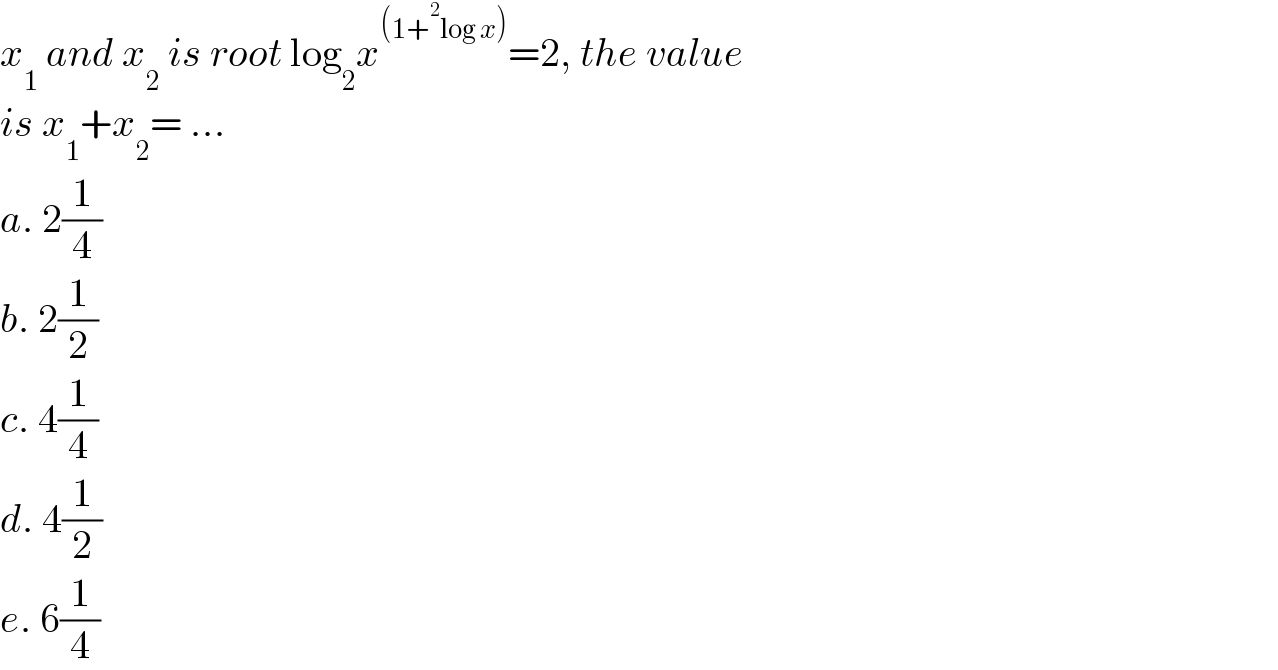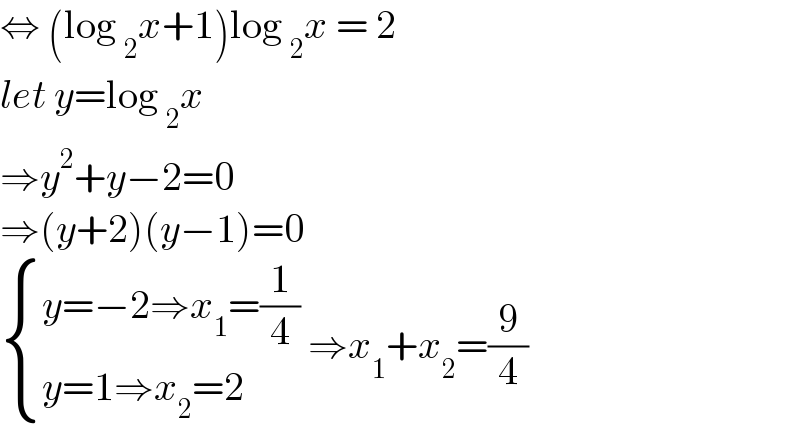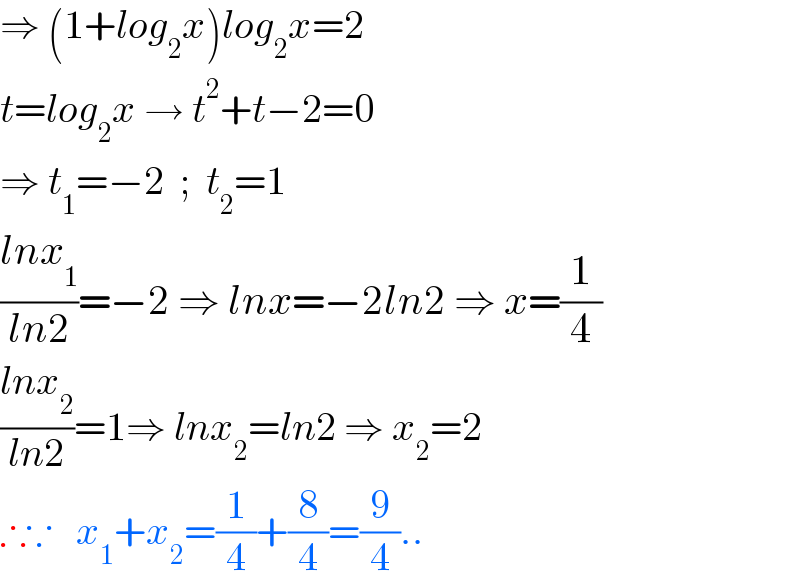Question Number 154989 by bagjagugum123 last updated on 24/Sep/21

$${x}_{\mathrm{1}} \:{and}\:{x}_{\mathrm{2}} \:{is}\:{root}\:\mathrm{log}_{\mathrm{2}} {x}^{\left(\mathrm{1}+^{\mathrm{2}} \mathrm{log}\:{x}\right)} =\mathrm{2},\:{the}\:{value} \\ $$$${is}\:{x}_{\mathrm{1}} +{x}_{\mathrm{2}} =\:… \\ $$$${a}.\:\mathrm{2}\frac{\mathrm{1}}{\mathrm{4}} \\ $$$${b}.\:\mathrm{2}\frac{\mathrm{1}}{\mathrm{2}} \\ $$$${c}.\:\mathrm{4}\frac{\mathrm{1}}{\mathrm{4}} \\ $$$${d}.\:\mathrm{4}\frac{\mathrm{1}}{\mathrm{2}} \\ $$$${e}.\:\mathrm{6}\frac{\mathrm{1}}{\mathrm{4}} \\ $$
Answered by john_santu last updated on 24/Sep/21

$$\Leftrightarrow\:\left(\mathrm{log}\:_{\mathrm{2}} {x}+\mathrm{1}\right)\mathrm{log}\:_{\mathrm{2}} {x}\:=\:\mathrm{2} \\ $$$${let}\:{y}=\mathrm{log}\:_{\mathrm{2}} {x} \\ $$$$\Rightarrow{y}^{\mathrm{2}} +{y}−\mathrm{2}=\mathrm{0} \\ $$$$\Rightarrow\left({y}+\mathrm{2}\right)\left({y}−\mathrm{1}\right)=\mathrm{0} \\ $$$$\begin{cases}{{y}=−\mathrm{2}\Rightarrow{x}_{\mathrm{1}} =\frac{\mathrm{1}}{\mathrm{4}}}\\{{y}=\mathrm{1}\Rightarrow{x}_{\mathrm{2}} =\mathrm{2}}\end{cases}\:\Rightarrow{x}_{\mathrm{1}} +{x}_{\mathrm{2}} =\frac{\mathrm{9}}{\mathrm{4}} \\ $$
Commented by bagjagugum123 last updated on 24/Sep/21

$${thank}\:{you}\:{very}\:{much}\:{Sir} \\ $$
Answered by puissant last updated on 24/Sep/21

$$\Rightarrow\:\left(\mathrm{1}+{log}_{\mathrm{2}} {x}\right){log}_{\mathrm{2}} {x}=\mathrm{2} \\ $$$${t}={log}_{\mathrm{2}} {x}\:\rightarrow\:{t}^{\mathrm{2}} +{t}−\mathrm{2}=\mathrm{0} \\ $$$$\Rightarrow\:{t}_{\mathrm{1}} =−\mathrm{2}\:\:;\:\:{t}_{\mathrm{2}} =\mathrm{1} \\ $$$$\frac{{lnx}_{\mathrm{1}} }{{ln}\mathrm{2}}=−\mathrm{2}\:\Rightarrow\:{lnx}=−\mathrm{2}{ln}\mathrm{2}\:\Rightarrow\:{x}=\frac{\mathrm{1}}{\mathrm{4}} \\ $$$$\frac{{lnx}_{\mathrm{2}} }{{ln}\mathrm{2}}=\mathrm{1}\Rightarrow\:{lnx}_{\mathrm{2}} ={ln}\mathrm{2}\:\Rightarrow\:{x}_{\mathrm{2}} =\mathrm{2} \\ $$$$\therefore\because\:\:\:{x}_{\mathrm{1}} +{x}_{\mathrm{2}} =\frac{\mathrm{1}}{\mathrm{4}}+\frac{\mathrm{8}}{\mathrm{4}}=\frac{\mathrm{9}}{\mathrm{4}}.. \\ $$
